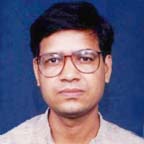Recent Colloquium
Colloquium # 277
What is the turbulence problem?
By Prof. Mahendra K. Verma,
Physics Department, Indian Institute of Technology, Kanpur, India
Monday, Sep 18th 2017 at 3:30 PM
Seminar Hall

Abstract
We hear that turbulence is an open physics problem, but researchers in different community have different perspectives on what is the turbulence problem. I will try to highlight and show that there are many facets to this problem. In particular, In 1941, Kolmogorov enunciated a universal theory of fluid turbulence according to which the energy spectrum of homogeneous and isotropic flows exhibit k^{-5/3} energy spectrum. Though many experiments and simulations verify the above law, the theory is not applicable in the presence of additional forces or walls. We will show in this talk that the buoyancy-driven stably-stratified flows show k^{-11/5} spectrum. In the thermally-driven turbulence, the velocity field follows Kolmgorov’s law, and the thermal plates have profound influence on the temperature spectrum.Rotation makes major part of a turbulent flow laminar.
Thus, Kolmogorov’s universal theory of turbulence is not so universal when additional forces or walls are introduced.
About the speakers
Prof. Mahendra Verma received his B. Tech. degree from of IIT Madras in Computer Science. Then he moved to University of Maryland for a PhD in Physics, and worked on MHD and solar wind turbulence. In 1994, he joined joined Indian Institute of Technology Kanpur as a faculty. Presently he is a Professor at IIT Kanpur.
Prof. Verma’s research interests include turbulence, nonlinear dynamics, high-performance computing, and non-equilibrium statistical physics. He is a recipient of Swarnajayanti fellowship, and author of more than 70 research papers, and a popular book “Introduction to Mechanics”. He and his group have developed a spectral code TARANG that can simulate variety of fluid flows.

